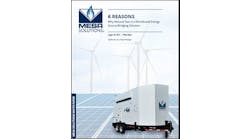Duke Energy has received more good news on its plan to build a renewable microgrid on Mount Sterling, this time with the staff of the North Carolina Utilities Commission (NCUC) recommending approval.
In addition, the North Carolina Sustainable Energy Association, often a tough critic of the utility, has given the project its blessing and encouraged Duke to pursue additional off-grid and grid-connected microgrids.
The latest boost for the Mt. Sterling microgrid follows a decision in January by the commission to forego a hearing because there was no opposition to the project.
The Mt. Sterling microgrid is small – only 10 kW of solar and 95 kWh of energy storage – but it is significant for a couple of reasons.
First, it is an energy project that actually improves the scenic view in the area. And second, it will be Duke’s first regulated investment in a remote, renewable microgrid, as well as its first direct current microgrid.
The project also is one of only a handful of microgrids that U.S. utilities are building without first getting pre-approval for cost recovery from state regulators.
In a recent filing, the NCUC staff recommended that the commission approve a certificate of public convenience and necessity, a key permit. Among other things, the staff said that the project appears to be cost effective. Duke plans to seek cost recovery in a future rate case.
“Although specific ratemaking decisions are reserved for the company’s next general rate case, the public staff believes that this treatment is reasonable,” said Michelle Boswell, commission staff accountant, in the filing.
The renewable microgrid is being built as a non-wires alternative for a critical facility. Located in Great Smoky Mountains National Park, the microgrid will replace a four-mile 12.47 kV grid-connected distribution feeder that is difficult to access and maintain. The power is needed for radio equipment used by the National Park Service.
Through a competitive solicitation, Duke chose Fluidic Energy as the primary engineering, procurement, and construction contractor and battery supplier. Fluidic Energy also will provide the ongoing operation and maintenance for the renewable microgrid, and install monitoring equipment.
The microgrid now awaits commission approval. It also must win an okay from the National Park Service on pole disposal activities.
Track news about renewable microgrid projects by subscribing to the free Microgrid Knowledge newsletter.






